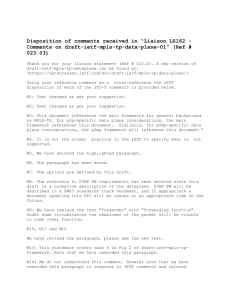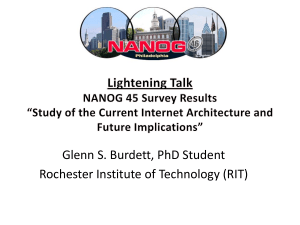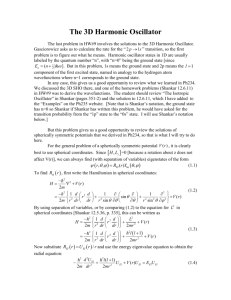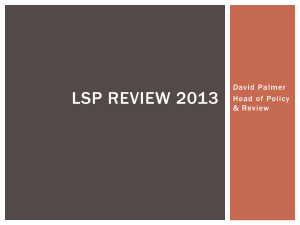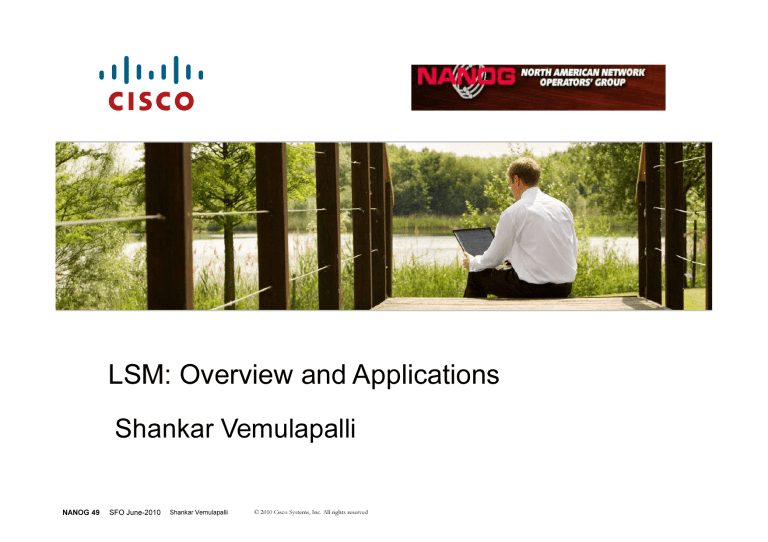
LSM: Overview and Applications
Shankar Vemulapalli
NANOG 49
SFO June-2010
Shankar Vemulapalli
© 2010 Cisco Systems, Inc. All rights reserved
Agenda
Need for Label Switched Multicast
Solutions
mLDP
p2mp TE
OAM Extensions for support of LSM
Applications
PIM SSM Transit for IPv4/IPv6
mVPN Deployments (Default/Data)
Video Contribution & Distribution
NANOG 49
SFO June-2010
Shankar Vemulapalli
© 2010 Cisco Systems, Inc. All rights reserved
2
Scope of the Presentation
Presentation is going to cover the motivations for the
Label Switched Multicast
Goes over the building blocks of how both mLDP and
P2MP-TE LSPs are set up
Look at the applications of the LSM
NANOG 49
SFO June-2010
Shankar Vemulapalli
© 2010 Cisco Systems, Inc. All rights reserved
3
What is LSM
Label Switched Multicast
MPLS Technology extensions to support multicast using Labels
Point-to-Multipoint LSPs
Multipoint-to-Multipoint LSPs
Multicast Label Switched Paths
Trees built using Labels
Native Multicast Mapped onto Multicast LSPs
NANOG 49
SFO June-2010
Shankar Vemulapalli
© 2010 Cisco Systems, Inc. All rights reserved
4
Drivers for LSM
Customers want to leverage their MPLS infrastructure for
transporting IP Multicast, so common data plane for unicast
and multicast
Service Providers asking for a tighter integration of
Multicast with MPLS Traffic Engineering and GMPLS for
their Triple Play Services
Unify forwarding between VPN Unicast & Multicast for
operational reasons in customer spaces using native
MPLS/VPN.
Simplification of Core Routers by removing PIM
NANOG 49
SFO June-2010
Shankar Vemulapalli
© 2010 Cisco Systems, Inc. All rights reserved
5
Drivers for LSM
Drivers for point-to-multipoint from Video Transport
Contribution
Point-to-Multipoint Video feeds, e.g, sports events to multiple broadcasters
Desire to have Video quality probes at each network hop for service assurance
and monitoring
Source Feed to Production Houses
Secondary Distribution
Implicitly required for IPTV BW Efficiency
Video Content to the end users
NANOG 49
SFO June-2010
Shankar Vemulapalli
© 2010 Cisco Systems, Inc. All rights reserved
6
Work at the Standards
Standardization work is happening at IETF for both LDP and RSVP
signaling protocols to carry labels for the multicast along with
extensions for OAM
mLDP
LDP Extensions to P2MP& MP2MP LSPs
draft-ietf-mpls-ldp-p2mp
LDP Capabilities
RFC 5561
In-Band Signaling
draft-ietf-mpls-mldp-in-band-signaling
P2MP TE
Signaling Req. for P2MP-TE LSPs
RFC 4461
Extensions to RSVP
P2MP LSP Extensions for LSP-Ping
RFC 4875
LSM OAM
draft-ietf-mpls-p2mp-lsp-ping
Proxy LSP Ping
draft-ietf-mpls-remote-lsp-ping
Connectivity Verification for Multicast LSPs
draft-ietf-mpls-mcast-cv
VPLS
LSM Support for VPLS
NANOG 49
SFO June-2010
Shankar Vemulapalli
© 2010 Cisco Systems, Inc. All rights reserved
RFC 5501
7
LSM Signaling Options
Multicast LDP
• LDP signaling extensions
Characteristics
• Receiver-initiated LSP
tree building
• Dynamic IGP-based LSP
tree building
• Dynamic IP multicast
receivers (and sources)
Applicability
and Drivers
• Fast ReRoute protection
of IP multicast traffic
• Simplified control plane
(i.e., LDP instead of PIM)
• Common MPLS
forwarding plane for
unicast and multicast
NANOG 49
SFO June-2010
Shankar Vemulapalli
© 2010 Cisco Systems, Inc. All rights reserved
P2MP RSVP TE
• RSVP signaling
extensions
• Source-initiated LSP tree
building
• Static/deterministic LSP
tree building
• Moderate number of
static IP multicast
receivers
• Fast ReRoute protection
of IP multicast traffic
• Traffic engineering of IP
multicast traffic
(constraint-based
routing, bandwidth
admission control)
8
LSM Architecture
LSM architecture supports a range of services or “clients”
Over mLDP and P2MP TE control planes
Services
IPv4
IPv6
IPv4
VPLS
mVPN
Native
mVPN
Native
IPv6
BGP
PIM
PORT
mLDP
P2MP TE
LSM OAM
LSM Forwarding
NANOG 49
SFO June-2010
Shankar Vemulapalli
© 2010 Cisco Systems, Inc. All rights reserved
9
Terminology
Terminology
Description
LSR
Label Switch Router
Ingress LSR
Router acting as a Sender of an LSP & is closest to multicast
source (Root Node)
Egress LSR
P2P LSP
Router acting as a Receiver of an LSP & is closest to the
multicast receiver (Leaf Node)
LSP with one Unique Ingress LSR & one Unique Egress LSR
P2MP LSP
LSP with one Unique Ingress LSR & one or more Egress LSRs
MP2MP LSP
LSP that has one or more Leaf LSRs acting as Ingress or
Egress
MP LSP
NANOG 49
SFO June-2010
Any type of Multipoint LSP
Shankar Vemulapalli
© 2010 Cisco Systems, Inc. All rights reserved
10
Terminology
Terminology
P2MP Tree
Upstream
Downstream
Branch LSR
Bud LSR
Leaf LSR
NANOG 49
SFO June-2010
Description
The ordered set of LSRs & links that comprise the path of a P2MP
LSP from its Ingress LSR to all of its Egress LSRs
Direction of the Multicast packet received from
( from Egress towards Ingress )
Direction of the Multicast packet sent to
(from Ingress towards Egress)
LSR of a P2MP or MP2MP LSP that has more than ONE
downstream LSR
LSR of P2MP or MP2MP LSP that is an Egress but also has one
or more directly connected downstream LSR(s)
Egress LSR of a P2MP or Ingress/Egress LSR of a MP2MP LSP
Shankar Vemulapalli
© 2010 Cisco Systems, Inc. All rights reserved
11
Terminology Mapping
PE3
PE3
PE2
PE2
PE5
P2
PE1
P1
Branch
LSR
P3
P2
PE1
PE6
P1
P3
Branch
LSR
PE4
PE5
PE6
PE4
PE3
PE2
PE1
P1
P2
PE5
P3
PE6 LSR
Bud
PE7
PE4
NANOG 49
SFO June-2010
Shankar Vemulapalli
© 2010 Cisco Systems, Inc. All rights reserved
12
mLDP
NANOG 49
SFO June-2010
Shankar Vemulapalli
© 2010 Cisco Systems, Inc. All rights reserved
13
mLDP
Receiver driven (Egress LSR) MP LSP Setup
Labels are distributed from the Leaves towards the Root
MP LSP Path Selection is based on Root Address
Derived from BGP NH of Source or Statically Configured
Supports P2MP & MP2MP Tree Construction
Downstream on demand label allocation
Labels are not allocated unless there is a receiver interested
Architecture supports In-Band & Overlay signaling
No PHP – The top label is used to identify tree
NANOG 49
SFO June-2010
Shankar Vemulapalli
© 2010 Cisco Systems, Inc. All rights reserved
14
mLDP Topology
Upstream Traffic (towards root)
PIM Enabled
PIM Free Core (No Native Multicast)
PIM Enabled
MPLS Core
Egress
Router
Source
Egress
Router
Ingress
Router
(Root)
P2MP LSP or MP2MP LSP
Downstream Traffic (away from root)
NANOG 49
SFO June-2010
Shankar Vemulapalli
© 2010 Cisco Systems, Inc. All rights reserved
Egress
Router
CE
CE
CE
Receiver
Receiver
Receiver
Node with a
receiver
15
mLDP – LDP Extensions
A P2MP Capability TLV is defined which will be carried in the Capabilities
Parameter as part of the INITIALIZATION Message
Initialization Message
Capabilites Parameter
P2MP Capability TLV
New mLDP Capabilities
New Capabilities
P2MP Capability
MP2MP Capability
NANOG 49
SFO June-2010
MBB Capability
Shankar Vemulapalli
© 2010 Cisco Systems, Inc. All rights reserved
Value
0x0508
0x0509
0x050A
16
mLDP – LDP Extensions
A new P2MP FEC Element will be advertised as part of the
FEC TLV in the Label Mapping message
Label Map Message
FEC TLV
FEC
Element
Label TLV
OV
New LDP FEC Element Types
FEC Element Types
P2MP FEC Type
MP2MP-UP FEC Type
MP2MP-Down FEC Type
NANOG 49
SFO June-2010
Shankar Vemulapalli
© 2010 Cisco Systems, Inc. All rights reserved
Value
0x06
0x07
0x08
17
mLDP – FEC Element
P2MP FEC Element
Consists of the Address of the Root of the P2MP LSP and
Opaque Value
Opaque Value consists of one or more LDP MP Opaque value
Elements
The Opaque Value is unique within the context of the Root Node.
The combination uniquely identifies a P2MP LSP with in the
MPLS Network
Root Node Address
Opaque Value
NANOG 49
SFO June-2010
Shankar Vemulapalli
© 2010 Cisco Systems, Inc. All rights reserved
18
mLDP – FEC Element
0
0
1
2
3
4
5
6
7
8
9
1
0
1
2
3
4
5
6
7
8
9
2
0
1
2
Address Family
Tree Type
3
4
5
6
7
8
9
3
0
1
Address Length
Root Node Address
Opaque Length
Parameters
Tree Type
Address Family
Address Length
Root Node Address
Opaque Value
NANOG 49
SFO June-2010
Shankar Vemulapalli
Opaque Value
Description
P2MP, MP2MP Up, MP2MP Down
Root node address format (IPv4 =1 or IPv6 = 2)
Number of octets in Root Address (IPv4 = 4, IPv6 = 16)
Host address of MP LSP Root (within MPLS core)
One or more TLVs uniquely identifying MP LSP within the in context of
the root
© 2010 Cisco Systems, Inc. All rights reserved
19
mLDP – Root Node Address
Root Address is selected by the Egress Router
Automatically derived from BGP next-hop or statically configured
Root address is used to build the MP LSP
Each router in the path does a routing table lookup on the
root to discover the next-hop.
Label mapping message then sent to that next-hop
Resulting in a dynamically created MP LSP
No pre-computed, traffic engineered path
NANOG 49
SFO June-2010
Shankar Vemulapalli
© 2010 Cisco Systems, Inc. All rights reserved
20
mLDP – Opaque Value Element
Opaque Value Element
Each MP LSP is identified by unique opaque value
which is used to uniquely identify the MP LSP
Carries information that is meaningful to Ingress LSRs
and Leaf LSRs but need not be interpreted by Transit
LSRs
It can represent the (S, G) stream (PIM-SSM Transit)
or can be an LSP Identifier to define the Default/Data
MDTs in an mVPN application
NANOG 49
SFO June-2010
Shankar Vemulapalli
© 2010 Cisco Systems, Inc. All rights reserved
21
mLDP – Opaque Value
4 Multicast Applications are supported with each with its own Opaque Value
Applications
IPv4 PIM-SSM Transit
IPv6 PIM-SSM Transit
Multicast VPN
Direct-MDT or VPNv4
Transit
NANOG 49
SFO June-2010
Shankar Vemulapalli
Description
Allows Global PIM-SSM Streams to be transported across
the MPLS-Core. The Opaque Value contains the actual
(S,G) which resides in the Global (mroute) table of the
Ingress & Egress PE Routers
Same as Above but for IPv6
VPNv4 Traffic to be transported across Default-MDT (MIPMSI) or Data-MDT (S-PMSI)
Allows VPNv4 streams to be directly built without the need
for the Default-MDT to exist
© 2010 Cisco Systems, Inc. All rights reserved
22
mLDP - Signaling
mLDP Signaling provides TWO Functions:
To Discover the FEC & its associated Opaque Value for a MP LSP
To assign a multicast flow to a MP LSP
mLDP uses two signalling methods:
In-Band Signaling
All egress routers use the same algorithm to construct the opaque value based on the
multicast stream they want to join.
That may include, Source, Group, RD, next-hop…
Egress routers interested in the same multicast stream will create the same FEC.
Ingress PE multicast component parses the FEC and knows what multicast stream to
forward.
Out-of-Band Signaling
Opaque value is assigned by the ingress Root PE.
Egress PE’s use an out-of-band signaling protocol to request the opaque value that
belongs to a multicast stream.
Egress routers use the opaque value to construct the FEC and build the tree.
Allows for aggregating multicast streams on a single MP-T.
NANOG 49
SFO June-2010
Shankar Vemulapalli
© 2010 Cisco Systems, Inc. All rights reserved
23
mLDP – In-Band Signaling Operation
CE-1
PIM Join
1.1.1.1
232.1.1.1
Source = 1.1.1.1
NANOG 49
SFO June-2010
Using SRC: 1.1.1.1 Root = PE-1
Opaque with In-Band Signaling
Opaque = (S, G)
Shankar Vemulapalli
PE-1
P
© 2010 Cisco Systems, Inc. All rights reserved
PIM Join
1.1.1.1
232.1.1.1
PE-2
CE-2
Receiver1
24
mLDP – Out-of-Band Signaling
Using SRC: 1.1.1.1 Root = PE-1
Opaque with In-Band Signaling
Opaque = (S, G)
CE-1
PIM Join
1.1.1.1
232.1.1.1
Source = 1.1.1.1
NANOG 49
SFO June-2010
w-Opaque FEC for
(S,G) with Label
Shankar Vemulapalli
PIM Join
1.1.1.1
232.1.1.1
Request FEC for (S,G)
PE-1
P
© 2010 Cisco Systems, Inc. All rights reserved
PE-2
CE-2
Receiver1
25
P2MP Basic Operation
Root
(S)
R4
Label Mapping P2MP DOWN
FEC: 200 Root: R4 Label: L3
S2
Join (S, G)
Receiver
NANOG 49
SFO June-2010
S1
Leaf
R3
R2
Label Mapping P2MP DOWN
FEC: 200 Root: R4 Label: L2
Shankar Vemulapalli
© 2010 Cisco Systems, Inc. All rights reserved
S0
Leaf
R1
Label Mapping P2MP DOWN
FEC: 200 Root: R4 Label: L1
Join (S, G)
Receiver
26
P2MP Basic Operation
G S Data
Root
R4
L3
(S,G)
S2
L2
Leaf
Receiver
NANOG 49
SFO June-2010
R2
Shankar Vemulapalli
(S,G)
S1
R3
S0
R3 incoming from S2
FEC 200 Down
L1
L2
L3
© 2010 Cisco Systems, Inc. All rights reserved
S0
S1
S2
F
F
A
L1
(S,G)
Leaf
R1
Receiver
27
MP2MP Basic Operation
Root
Join (S, G)
R5
R4
Label Mapping:
MP2MP UP
FEC: 200 Label: L6
Label Mapping:
MP2MP DOWN
FEC: 200 Root: R4 Label: L3
S2
Label Mapping:
MP2MP UP
FEC: 200 Label: L3
S1
Join (S, G)
Receiver
NANOG 49
SFO June-2010
R3
R2
Label Mapping:
MP2MP DOWN
FEC: 200 Root: R4 Label: L2
Shankar Vemulapalli
© 2010 Cisco Systems, Inc. All rights reserved
Label Mapping:
MP2MP UP
FEC: 200 Label: L4
S0
Join (S, G)
R1
Label Mapping:
MP2MP DOWN
FEC: 200 Root: R4 Label: L1
28
MP2MP Basic Operation
Look at R3 Downstream Label Replication Table from S2
R4
Downstream
DOWN Label: L3
UP Label: L6
L3
L2
L1
S2
DOWN Label: L2
UP Label: L3
S1
R3
SFO June-2010
Shankar Vemulapalli
DOWN Label: L1
UP Label: L4
R1
R2
NANOG 49
S0
© 2010 Cisco Systems, Inc. All rights reserved
29
MP2MP Basic Operation
Look at R3 Upstream Label Replication Table from S1
R4
DOWN Label: L3
UP Label: L6
S2
DOWN Label: L2
UP Label: L3
R2
S1
R3
Upstream
L3
S0
DOWN Label: L1
UP Label: L4
R1
L6
L1
NANOG 49
SFO June-2010
Shankar Vemulapalli
© 2010 Cisco Systems, Inc. All rights reserved
30
MP2MP Basic Operation
Look at R3 Upstream Label Replication Table from S0
R4
DOWN Label: L3
UP Label: L6
S2
DOWN Label: L2
UP Label: L3
S1
R3
S0
DOWN Label: L1
UP Label: L4
Upstream
R2
L4
L6
R1
L2
NANOG 49
SFO June-2010
Shankar Vemulapalli
© 2010 Cisco Systems, Inc. All rights reserved
31
P2MP TE
NANOG 49
SFO June-2010
Shankar Vemulapalli
© 2010 Cisco Systems, Inc. All rights reserved
32
P2MP TE
Extensions to RSVP-TE Protocol are defined via RFC
4875 to support P2MP TE LSPs
P2MP TE LSP is initiated by the Ingress LSR towards
the Egress LSRs
Supports only P2MP LSPs
Support Traffic Engineering
Explicit Routing
Fast ReRoute
BW Reservation
NANOG 49
SFO June-2010
Shankar Vemulapalli
© 2010 Cisco Systems, Inc. All rights reserved
33
Terminology
Common Terms are covered earlier as part of the Introduction.
Ingress LSR
Downstream
Terminology
Sub-LSP
S2L Sub-LSP
Grafting
Pruning
Crossover
Remerge
NANOG 49
SFO June-2010
Egress LSR
Branch LSR
P2P LSP
Bud LSR
P2MP LSP
Leaf LSR
Upstream
Description
A segment of a P2MP TE LSP that runs from one of the LSP’s
LSRs to one or more of its other LSRs
Source to Leaf: A segment of a P2MP TE LSP that runs from HE
to one Destination
The operation of adding egress LSR(s) to an existing P2MP LSP
An action where Egress LSR is removed from the P2MP LSP
Crossover happens at an intersecting node when two or more
incoming Sub-LSPs, belonging to the same LSP, have different
input & different output interfaces
Remerge happens at an intersecting node when two datastream
belonging to the same P2MP LSP Merge into one datastream on
output
Shankar Vemulapalli
© 2010 Cisco Systems, Inc. All rights reserved
34
Extensions to RSVP for P2MP TE
P2MP ID
SESSION
Tunnel ID
Extended Tunnel ID
Tunnel Sender Address
P2MP
SENDER_TEMPLATE
LSP ID
Sub-Group Originator ID
Sub-Group ID
S2L Sub-LSP
NANOG 49
SFO June-2010
Shankar Vemulapalli
© 2010 Cisco Systems, Inc. All rights reserved
Destination
35
P2MP TE LSP
It is ONE or MORE S2L Sub-LSPs
It is a collection of all Sub-LSPs forms the P2MP LSP
All Sub-LSPs belonging to the same P2MP LSP should share
labels and resources when they share links
Share labels to prevent multiple copies of the same data being sent
Identified by 5-Tuple Key
SESSION
SENDER_TEMPLATE
NANOG 49
SFO June-2010
Shankar Vemulapalli
P2MP ID
Tunnel ID
Tunnel Sender Address
© 2010 Cisco Systems, Inc. All rights reserved
EXT. Tunnel ID
LSP ID
36
P2MP TE : Sub-LSPs
P2MP
LSP
Tunnel
PE1
P1
P2
Sub-LSPs
PE2
PE3
P3
PE4
Sub-LSPs
NANOG 49
SFO June-2010
Shankar Vemulapalli
© 2010 Cisco Systems, Inc. All rights reserved
37
P2MP: Sub-LSPs Rejoin - Crossover
P2MP
LSP
Tunnel
PE1
P1
P2
PE2
Crossover
P3
A CROSSOVER is a ReJoin where the Sibling
Sub-LSPs are going out onto two different streams
PE3
Sub-LSPs
NANOG 49
SFO June-2010
Shankar Vemulapalli
© 2010 Cisco Systems, Inc. All rights reserved
38
P2MP TE : Sub-LSPs Rejoin - ReMerge
P2MP
LSP
Tunnel
PE1
P2
ReMerge
P1
P3
REMERGE happens at an intersecting node when
two datastream belonging to the same P2MP
LSP merge into onto one datastream on output.
PE2
PE3
Sub-LSPs
NANOG 49
SFO June-2010
Shankar Vemulapalli
© 2010 Cisco Systems, Inc. All rights reserved
39
P2MP TE: Sub-LSP Operation - Grafting
P2MP
LSP
Tunnel
PE1
P1
PE2
P2
Grafting
PE3
P3
PE4
GRAFTING happens when a new Egress is added to an existing
P2MP LSP. i.e., a new Sub-LSP (New SubGroup ID, New DST)
is signaled with a new destination for an existing P2MP LSP (Same LSP ID)
NANOG 49
SFO June-2010
Shankar Vemulapalli
© 2010 Cisco Systems, Inc. All rights reserved
40
P2MP TE: Sub-LSP Operation - Pruning
P2MP
LSP
Tunnel
PE1
P1
PE2
P2
Pruning
PE3
P3
PE4
The operation of removing Egress LSRs from an existing P2MP LSP is termed PRUNING
NANOG 49
SFO June-2010
Shankar Vemulapalli
© 2010 Cisco Systems, Inc. All rights reserved
41
P2MP TE: Signaling
Root
Static or BGP A-D
(S)
R4
S2
PIM Join
Receiver
NANOG 49
SFO June-2010
Leaf
S1
R3
Leaf
R1
R2
Shankar Vemulapalli
S0
© 2010 Cisco Systems, Inc. All rights reserved
PIM Join
Receiver
42
P2MP TE: Signaling
Root
(S)
R4
PATH
SESSION
SENDER_TEMPLATE
Ext Tun ID
LSP ID
S2L Destination
P2MP ID
Leaf
S1
R3
© 2010 Cisco Systems, Inc. All rights reserved
S2L Sub-LSP
Label
Tunnel Sender
LSP ID
S2L Destination
#
Sub Group
Originator
Ext Tun ID
Sub Group ID
S0
Leaf
R1
R2
Shankar Vemulapalli
FILTER_SPEC
Tun ID
S2
Sub Group ID
Receiver
SFO June-2010
SESSION
Sub Group Originator
PIM Join
NANOG 49
S2L Sub-LSP
Tunnel Sender
P2MP ID
Tun ID
RESV
PIM Join
Receiver
43
OAM Extensions for
support of LSM
NANOG 49
SFO June-2010
Shankar Vemulapalli
© 2010 Cisco Systems, Inc. All rights reserved
44
MPLS OAM for Multicast
Multicast LSP Ping
Proxy LSP Ping
Multicast Connectivity Verification
NANOG 49
SFO June-2010
Shankar Vemulapalli
© 2010 Cisco Systems, Inc. All rights reserved
45
Multicast LSP Ping
R2
R3
R4
R5
R1
R6
MPLS Echo Request
R7
MPLS Echo Reply
R10
R9
R8
Adds FEC Stack sub-TLVs for P2MP-TE and mLDP
Adds capability to limit and jitter response
Bud node indication (acting as both an egress and a mid-point)
NANOG 49
draft-ietf-mpls-p2mp-lsp-ping
SFO June-2010
Shankar Vemulapalli
© 2010 Cisco Systems, Inc. All rights reserved
46
Proxy Ping Motivation
Scalability
Reduce
number of replies
network wide processing of MPLS Echo Requests
Scoping can limit the number of replies but still requires
processing at the ‘replying’ node
In some cases, scoping is not desired, but responses are only
needed from a small region of the topology
Previous Hop Information
Needed with mLDP
NANOG 49
SFO June-2010
Shankar Vemulapalli
© 2010 Cisco Systems, Inc. All rights reserved
47
Proxy LSP Ping
Proxy Echo Request
Proxy Echo Reply
Echo Request
Echo Reply
draft-ietf-mpls-remote-lsp-ping
NANOG 49
SFO June-2010
Shankar Vemulapalli
© 2010 Cisco Systems, Inc. All rights reserved
48
P2MP TE Fault Localization
In Traffic Engineering, the topology of the tree is
known
The branches which proceed towards the node
reporting trouble can be determined
By initiating trace further into the tree, traffic on the
other branches can be avoided
NANOG 49
SFO June-2010
Shankar Vemulapalli
© 2010 Cisco Systems, Inc. All rights reserved
49
P2MP TE Tracing with Proxy LSP Ping
Traffic on other branches avoided by initiating trace
further into tree
Proxy Echo Request
Echo Request
NANOG 49
SFO June-2010
Shankar Vemulapalli
Note: Echo Replies not shown
© 2010 Cisco Systems, Inc. All rights reserved
50
Multicast LDP Tracing
mLDP LSPs are initiated by the leaf nodes
Root node may not know the tree topology
Failure is most likely to be detected at leaf
Leaf is a logical place to begin tracing
NANOG 49
SFO June-2010
Shankar Vemulapalli
© 2010 Cisco Systems, Inc. All rights reserved
51
mLDP Traceroute
Proxy Echo Request
Proxy Echo Reply
Echo Request
Echo Reply
NANOG 49
SFO June-2010
Shankar Vemulapalli
Tree is traced from leaf to root
PHOPs are learned as trace progresses
© 2010 Cisco Systems, Inc. All rights reserved
52
Requirements for Multicast Connectivity
Verification
Most P2MP-TE applications will require strong OAM
Television feeds
Stock ticker
Scaling
Operators require low-impact on network.
Must deal with many endpoints (1000s)
Auto-configuration
Simple initial configuration
Automatic OAM configuration on Prune/Join
Many applications will use egress repair
P2MP TE LSP
L2
SW
Multicast
Server
P2MP TE LSP
Failover requirement is 50 ms
NANOG 49
SFO June-2010
Shankar Vemulapalli
© 2010 Cisco Systems, Inc. All rights reserved
53
Multicast CV Setup
Multicast CV Configuration
MPLS Echo Reply
NANOG 49
SFO June-2010
Shankar Vemulapalli
© 2010 Cisco Systems, Inc. All rights reserved
54
LSM Applications
NANOG 49
SFO June-2010
Shankar Vemulapalli
© 2010 Cisco Systems, Inc. All rights reserved
55
Use Case: PIM-SSM Transit
Supports IPv4 and IPv6 SSM multicast traffic
Carried across core in P2MP LSP
Source and Group are encoded into opaque value
Signalling of (S, G) state is done in-band
Label Mapping message builds tree to root
Root is edge router connected to source (injects BGP route)
Source prefixes distributed via BGP
Root derived from BGP Next-Hop of Source
PIM is present on the edge of the network
P2MP LSP in core of network
NANOG 49
SFO June-2010
Shankar Vemulapalli
© 2010 Cisco Systems, Inc. All rights reserved
56
Use Case: PIM-SSM Transit
iBGP Session
Sender
Source
Group
PE
P2MP LSP
MPLS/IP
Network
P
PIM Free Zone
PE
PIM-SSM Transit
IPv4/v6 Opaque Value
PE
PE Routers need to know the S and G (SSM)
Solution for Multicast in Global Table
Allows global PIM-SSM streams to be transported
across the MPLS Core
Source Prefixes distributed via BGP
Useful when there is a need for carrying IP
multicast over a MPLS network where there is an
explicit requirement for MPLS encapsulation.
PE
Receiver
Receiver
Receiver
NANOG 49
SFO June-2010
Shankar Vemulapalli
© 2010 Cisco Systems, Inc. All rights reserved
57
Use Case: Multicast VPN over mLDP
mLDP supports Multicast Distribution Trees (mVPNs)
mVPN solution is independent of the tunnelling mechanism
PIM with GRE encapsulation (Native Multicast)
mLDP with MPLS encapsulation
Default-MDT uses MP2MP LSPs
Supports low bandwidth and control traffic between VRFs
Data-MDT uses P2MP LSPs
Supports single high bandwidth source stream from a VRF
All other operation of the mVPN remains the same
PIM neighbors in VRF seen across LSP-VIF
VPN multicast state signalling via PIM
VPN-ID is used in place of MDT Multicast Group address
NANOG 49
SFO June-2010
Shankar Vemulapalli
© 2010 Cisco Systems, Inc. All rights reserved
58
Use Case: Multicast VPN over mLDP
Default-MDT
Default MDT
Sender
PE
MDT# = 0
The MPLS Core forms a Default-MDT for a given
customer
MPLS/IP
Network
PIM Join
VPN-ID
Customer CE Devices joins the MPLS-Core
through Provider’s PE Devices
PE
Multicast
VPN
MDT Opaque Value
Default
MDT
PE
The Opaque Value used to signal a Default MDT
It has two parameters:
VPN-ID
MDT number
PE
Receiver
MVPN associates an interface for head and tailend on the MP2MP LSP (just like a Tunnel
interface).
Receiver
Receiver
NANOG 49
SFO June-2010
Shankar Vemulapalli
© 2010 Cisco Systems, Inc. All rights reserved
59
Use Case: Multicast VPN over mLDP
Data-MDT
Data MDT
Sender
PE
VPN-ID
MDT# > 0
Optionally a Data-MDT can be built based on
traffic thresholds on sending PE when high BW
source appears in the customer network.
MPLS/IP
Network
Multicast
VPN
MDT Opaque Value
Data-MDT uses P2MP LSPs to support high BW
(S,G) Stream
Data
MDT
Data-MDTs built for (S,G) in the mVPN
PE
PE
PE
Receiver
The Opaque value is used to signal Data-MDT
VPN-ID
MDT #
(S,G)
Receiver
Receiver
NANOG 49
SFO June-2010
Shankar Vemulapalli
© 2010 Cisco Systems, Inc. All rights reserved
60
Use Case: P2MP TE for Video Contribution
Video Contribution
Typical Users:
P2MP TE
Regional Studio
Sport Events
• Broadcasters
• Content distribution providers
Deployment Requirements:
• Bandwidth management
• Explicit networks paths
MPLS/IP
Network
• P2MP traffic distribution
• Network failure protection
NANOG 49
Postproduction
Postproduction
Video Data Center
Video Data Center
SFO June-2010
Shankar Vemulapalli
© 2010 Cisco Systems, Inc. All rights reserved
LSM Application:
• Constrained-based P2MP TE
tunnels (explicit paths, BW)
• TE FRR for link protection
Video Contribution Network
Video
Sender
An typical P2MP TE Deployment for the
Video distribution
Video
Sender
TE Head-end
TE Head-end
MPLS/IP
Network
Selective
Replication
Path
Diversity
Two Methods to push the Video
1. Push the replication as close to the
receivers as possible
2. Two LSPs in the core with active and
back up role
TE Tail-end
Video
Video
Receiver Receiver
Video
Receiver
NANOG 49
SFO June-2010
Shankar Vemulapalli
Video
Receiver
© 2010 Cisco Systems, Inc. All rights reserved
62
Use Case: FRR for Traffic Protection
RSVP-TE P2MP supports FRR using unicast link protection.
mLDP also supports FRR using RSVP TE unicast link
protection
Technology allows FRR protection on a per core tree basis
for MLDP
Ability to choose what type of traffic to go to the backup link
(if there is concern like cost on backup link, etc.)
NANOG 49
SFO June-2010
Shankar Vemulapalli
© 2010 Cisco Systems, Inc. All rights reserved
63
Common LSP Protocol in the Core
RSVP-TE vs LDP
Each protocol has its pros and cons
MLDP and P2MP TE can coexist in a network
•MLDP for general purpose MVPN or global multicast
routing;
•P2MP TE for application like studio to studio traffic which
may require BW reservation
NANOG 49
SFO June-2010
Shankar Vemulapalli
© 2010 Cisco Systems, Inc. All rights reserved
64
Summary
Label Switched Multicast (LSM) offers RSVP and LDP
extensions for optimized P2MP MPLS forwarding
Depending up on the application requirements, either of the
P2MP and MP2MP LSPs can be used
OAM Extensions for support of LSM are being enhanced via
Multicast LSP Ping, Proxy LSP Ping and Multicast CV
Typical LSM Applications are for mVPN, PIM SSM Transit,
Enterprise & Service Provider Video Contribution &
Distribution
NANOG 49
SFO June-2010
Shankar Vemulapalli
© 2010 Cisco Systems, Inc. All rights reserved
65

